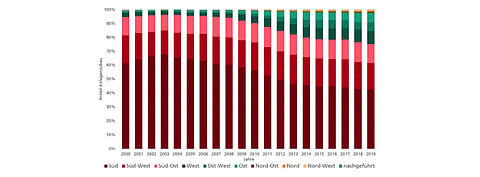

The largest growth in solar PV capacity in Germany has been taking place in the rooftop solar PV systems space larger than 100 kW capacity, according to the Energy Systems Analysis department of Fraunhofer Institute for Solar Energy Systems. These systems account for 38% of new PV systems installed.
In PV Additions in Germany in Numbers (Photovoltaikzubau in Deutschland in Zahlen), a brief study published looking at solar systems installed since the start of the German feed-in tariff law (EEG) in 2000 and 2019, the ISE authors have also pointed out an interesting trend, that 22% of the newly installed systems are facing west, east or east-west, and 19% of these are having tilt angles smaller than 20º.
Between 2000 to 2019, the share of PV systems with southern orientation decreased from 61% to 42%, those with eastern orientation increased from 1% to 7%, west orientations from 3% to 9%, and east/west orientations from 1% to 6%, according to the study.
The authors have noticed the annual share of additional PV systems deployed with a tilt angle of less than 20º averaged between 2000 and 2009, and from 2010 to 2019 its share increased to an average of 19%. Plants with tilt angles between 20º and 40º accounted for an average share of 63% between 2000 and 2009, but between 2010 and 2019 its share dropped to 54%.
"Only about a quarter of the newly installed plants in 2019 have no output limitation. About 66% of all newly installed plants are limited to a maximum grid feed-in of 70% of their output power under the EEG, due to the fact that they have no remote controllable feed-in management," as per the study. "Since 2014, this proportion has grown by an average of 4 percentage points per year. The remaining plants with output limitations are bound by even higher limitations ranging from 60% to 50% due to the combined battery storage system."
In terms of size, the share of rooftop solar systems ranging between 100 kW to 750 kW increased from 17% in 2017 to 38% in 2019, whereas the share of 82% of PV plants in the range of less than 10 kW has remained relatively constant since 2014 on annual basis.
Among other significant findings of the study, Fraunhofer ISE founds that more than half of the PV systems are no longer being built in Bavaria and Baden-Württemberg since their collective share among new installations in the country between 2000 and 2009 was 59.6%, but declined to an average of 44.5% between 2010 and 2019. "Despite their declining share, Bavaria and Baden-Württemberg remain in first and second place in terms of new installations in 2019, with 24.4% and 18.6%, respectively. They are followed by the states of North Rhine-Westphalia, Lower Saxony and Hesse with 17.9%, 9.2% and 6.1%, respectively."
The full study is available on Fraunhofer ISE's website in German language.
.png?w=50&fm=png)